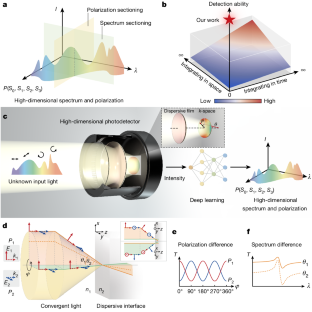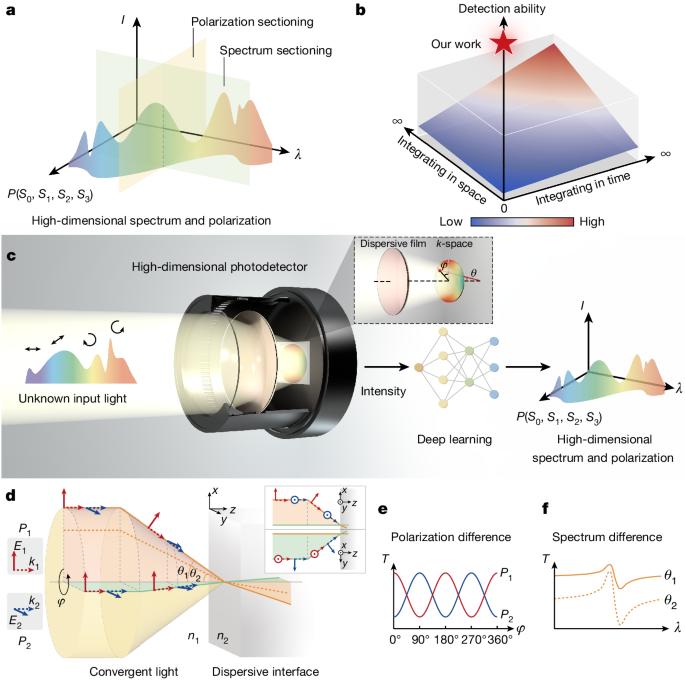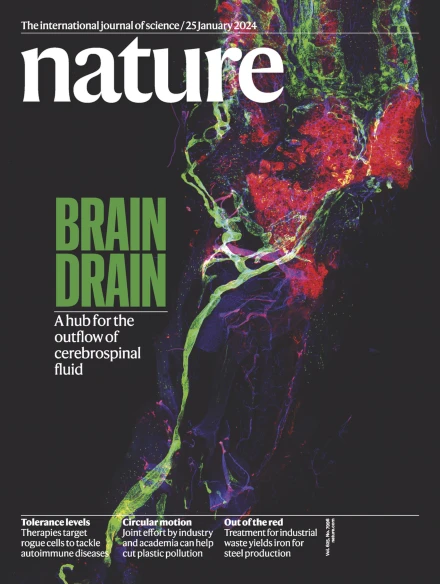Dispersion-assisted high-dimensional photodetector
IF 50.5
1区 综合性期刊
Q1 MULTIDISCIPLINARY SCIENCES
引用次数: 0
Abstract
Intensity, polarization and wavelength are intrinsic characteristics of light. Characterizing light with arbitrarily mixed information on polarization and spectrum is in high demand1–4. Despite the extensive efforts in the design of polarimeters5–18 and spectrometers19–27, concurrently yielding high-dimensional signatures of intensity, polarization and spectrum of the light fields is challenging and typically requires complicated integration of polarization- and/or wavelength-sensitive elements in the space or time domains. Here we demonstrate that simple thin-film interfaces with spatial and frequency dispersion can project and tailor polarization and spectrum responses in the wavevector domain. By this means, high-dimensional light information can be encoded into single-shot imaging and deciphered with the assistance of a deep residual network. To the best of our knowledge, our work not only enables full characterization of light with arbitrarily mixed full-Stokes polarization states across a broadband spectrum with a single device and a single measurement but also presents comparable, if not better, performance than state-of-the-art single-purpose miniaturized polarimeters or spectrometers. Our approach can be readily used as an alignment-free retrofit for the existing imaging platforms, opening up new paths to ultra-compact and high-dimensional photodetection and imaging. By combining spatial and frequency dispersive thin-film interfaces with deep residual learning, a miniature photodetector allowing the acquisition of high-dimensional information on light in a single-shot fashion is described.


色散辅助高维光电探测器。
强度、偏振和波长是光的固有特性。利用任意混合的偏振和光谱信息来描述光的特性是非常有必要的1-4。尽管在偏振计5-18 和光谱仪19-27 的设计方面做出了大量努力,但同时获得光场强度、偏振和光谱的高维特征仍具有挑战性,通常需要在空间或时间域对偏振和/或波长敏感元件进行复杂的集成。在这里,我们证明了具有空间和频率色散的简单薄膜界面可以在波矢域中投射和定制偏振和光谱响应。通过这种方法,可以将高维光信息编码到单次成像中,并在深度残差网络的帮助下进行解密。据我们所知,我们的工作不仅能够通过单个设备和单次测量,对宽带光谱中任意混合的全斯托克斯偏振态光进行全面表征,而且还具有与最先进的单用途微型偏振仪或光谱仪相当甚至更好的性能。我们的方法可作为现有成像平台的免对准改装件,为超小型高维光电探测和成像开辟了新的途径。
本文章由计算机程序翻译,如有差异,请以英文原文为准。
求助全文
约1分钟内获得全文
求助全文
来源期刊

Nature
综合性期刊-综合性期刊
CiteScore
90.00
自引率
1.20%
发文量
3652
审稿时长
3 months
期刊介绍:
Nature is a prestigious international journal that publishes peer-reviewed research in various scientific and technological fields. The selection of articles is based on criteria such as originality, importance, interdisciplinary relevance, timeliness, accessibility, elegance, and surprising conclusions. In addition to showcasing significant scientific advances, Nature delivers rapid, authoritative, insightful news, and interpretation of current and upcoming trends impacting science, scientists, and the broader public. The journal serves a dual purpose: firstly, to promptly share noteworthy scientific advances and foster discussions among scientists, and secondly, to ensure the swift dissemination of scientific results globally, emphasizing their significance for knowledge, culture, and daily life.
 求助内容:
求助内容: 应助结果提醒方式:
应助结果提醒方式:


